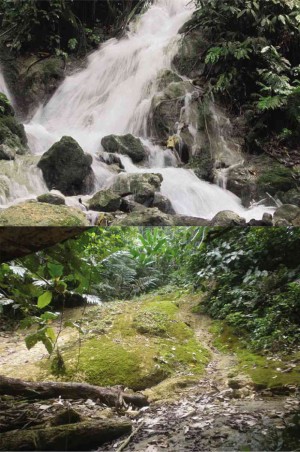Town’s water source gone after 7.2-maagnitude quake

Photos show the natural spring bustling before with potable water captured by the intake water box (top) and the dried-up spring and pipes after the earthquake on Tuesday that also shook Rosario town, Agusan del Sur province. PHOTOS BY CHRIS V. PANGANIBAN AND COURTESY OF MUNICIPAL GOVERNMENT
ROSARIO, Agusan del Sur—The spring that residents of eight of this town’s 11 villages depend on for their drinking water dried up following Tuesday’s 7.2-magnitude earthquake that hit Bohol province and other parts of the Visayas and Mindanao.
The disappearance in the aftermath of the tremor of water at the Maputi Spring, where a World Bank-funded P47-million water system facility was being installed, puzzled residents, who found themselves suddenly becoming waterless on Wednesday.
Even local officials were at a loss as to why the spring went dry when it was flowing abundantly hours before the tremor struck.
The earthquake killed more than 100 people and damaged millions of pesos in properties and infrastructure, including centuries-old structures considered to be part of Filipino heritage.
Vice Mayor Julie Chua said the town government had asked the Mines and Geosciences Bureau to conduct an assessment so that the phenomenon could be properly explained.
Article continues after this advertisementChua said the town government also wanted to know if there was a possibility that the spring would flow again or if there was a need to take some steps to bring it back to life.
Article continues after this advertisementIf there was no more possibility the spring would flow or make it produce water again, the multimillion water system project that was being constructed to harness its water just become useless and wasted, he said.
Joselito Serrano, planning assistant at the Municipal Planning and Development Office, said the water system project being undertaken by the Mindanao Rural Development Program started in July last year.
Even if it was just about 80 percent completed, it has started supplying drinking water to thousands of residents in Barangay (village) Poblacion and its seven adjoining villages, Serrano said.
He described the Maputi Spring as a major water source that could supply water to nearly 40,000 residents of this second-class municipality.
While officials here suspected that a major earth movement caused the spring to run dry, some residents said they believed that unabated illegal small-scale mining near the watershed that hosted the Maputi Spring should be blamed for the phenomenon.
They said the illegal mining activities might have disturbed the natural flow of water from the underground aquifer.
Chua admitted that there were indeed earth-moving activities at gold mining tunnels near the Maputi Spring but hinted that these were possibly not enough to disturb the flow of water from the underground aquifer.
Chua admitted that little was known about the spring and how it came into being.
Before the World Bank-backed water system facility was implemented, no geological fault analysis had ever been conducted, he said.